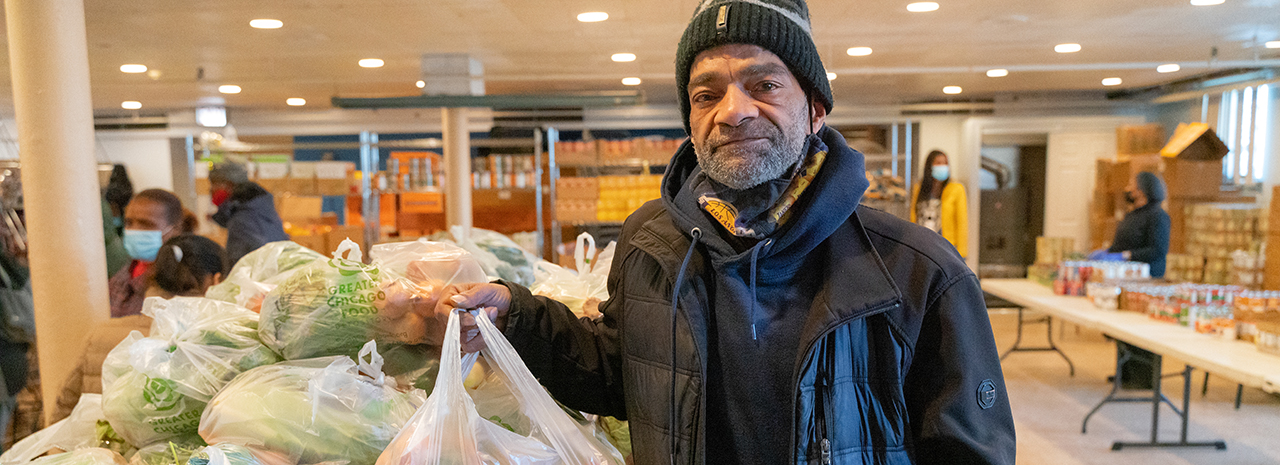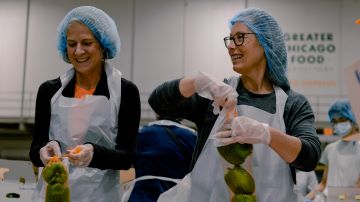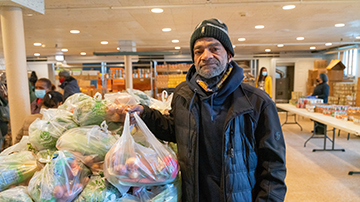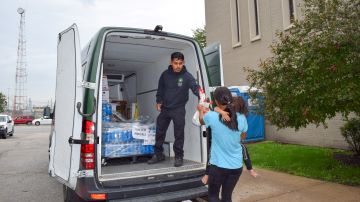
Responding to sustained high need
Hunger persists in our community. Though the worst days of the pandemic appear to be behind us, hundreds of thousands of our neighbors are challenged by the subsequent rise in inflation, high food prices and a shrinking federal safety net.
Food insecurity and the need for food in Chicago and Cook County remain elevated. By the end of the fiscal year (June 2023), one in five households in the Chicago Metro area and one in four households with children were food insecure – similar to rates seen during the first few months of the pandemic.
As a result, many families are turning to food pantries for the first time. In June 2023, our network of partner pantries across Cook County served more than 177,000 households (approximately 393,000 individuals) – 25 percent more households than last June.
Our neighbors served by food pantries include East Garfield Park residents Nikkitta Johnson and Iris Dickinson. When faced with an unexpected car expense, they suddenly found themselves in an unprecedented situation – their two incomes were not enough to cover the vehicle repair, their rent and a full month of groceries.
“It has been pretty stressful, I’m not going to lie,” said Dickinson, 25, who works in customer service and needs her car to get to work.
Like many in the area, they live paycheck to paycheck. This was mostly manageable until food prices skyrocketed amid historic inflation.
“We are a two-income household and even with our jobs we are still using up everything,” added Johnson, 27, a graphic designer.
Luckily, their local pantry, Breakthrough Urban Ministries’ Fresh Market, was there for them. The grateful couple now uses the pantry to supplement what they can afford at the grocery store. Stories like Johnson and Dickinson’s highlight the crucial role pantry partners play in the emergency food system, especially during times of heightened community need.
"We are a two-income household and even with our jobs we are still using up everything."
Nikkitta Johnson, Breakthrough Urban Ministries’ Fresh Market pantry guest
Poverty in America rose dramatically in 2023, when many pandemic-era benefits such as the emergency Supplemental Nutrition Assistance Program (SNAP) benefits and the child tax credit expired. As a result, food insecurity increased, overwhelming many.
Tim Wennerberg, 59, used to receive $260 a month in emergency SNAP benefits that were introduced in April 2020 to help people buy food during the pandemic. However, when a federal policy change eliminated the emergency benefits two months early at the end of February, his monthly SNAP allocation plummeted to $60.
“Who can live on that?” asked Wennerberg, standing at the food pantry at First Presbyterian Kimbark in the Woodlawn neighborhood. “That’s cutting it close.”
The change left Wennerberg, and countless others like him already living on the razor’s edge, scrambling to find alternative food sources at a time when food prices are still elevated.
Before, Wennerberg said, the items he picked up from the pantry helped to supplement groceries he purchased with his SNAP benefits. Now, he will need to rely almost solely on the food pantry.
“Why are they cutting our benefits now when (food) prices have gone higher? We need them now,” asked Avery Roche, 56, during an April visit to New Mount Calvary Baptist Church’s pantry. “The food I get here helps me through the month. I don’t get much (SNAP). The pandemic made it really hard to make (benefits) stretch.”
Pantry coordinators are just as worried.
“Our numbers are going to get higher because the (emergency) SNAP payments are ending,” warned Raletta Ingram, who co-manages the New Mount Calvary Baptist Church’s pantry.
Wennerberg and Roche are among two million SNAP recipients in Illinois who saw their monthly benefits reduced in March, becoming a source of intense stress for many households.
In fiscal year 2023 (FY23) alone, our Benefits Outreach Team and community partners submitted 3,728 SNAP and Medicaid applications on behalf of our neighbors, helping households maximize every public assistance program they’re eligible for.
It is likely to take many more months, if not years, for households to regain financial stability after the challenges of the last few years. And the elevated need for food is expected to continue throughout the next fiscal year.
The Food Depository is working hard to ensure our partner pantries’ shelves remain stocked, even as U.S. Department of Agriculture (USDA) food supplies returned to pre-pandemic levels and food insecurity remains elevated. In FY21, 56 percent of the Food Depository’s food came from the USDA under the federal Coronavirus Food Assistance Program (CFAP). That number dropped to 31 percent in FY22 when CFAP expired. Similarly, in FY23, USDA food accounted for 25 percent of the food we distributed.
To ensure food is available for everyone who needs it, the Food Depository is purchasing more. In FY21, 27 percent of our food was purchased. In FY22, that figure jumped to 48 percent, while in FY23 49 percent of our food was purchased.
We’ve also strengthened our Community Food Rescue program to support our network of partners. We have adopted a more efficient and collaborative “hub and spoke” model whereby a designated community partner collects quality, surplus food from local grocers for distribution to neighboring food pantries, soup kitchens, shelters and other programs. To facilitate this, the Food Depository provides a capacity-building grant for the partner to either purchase or retrofit a cold storage truck or van.
This work would not be possible without the generosity of our supporters. Together with our network, we remain committed to helping families put food on the table. Together we can end hunger.




